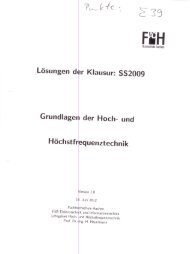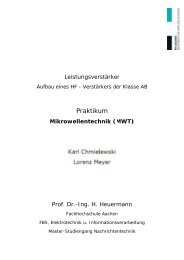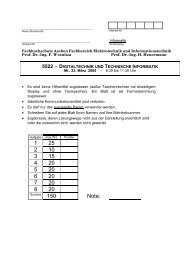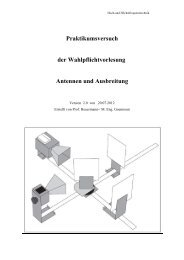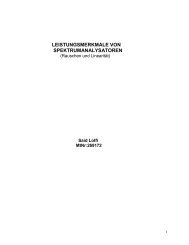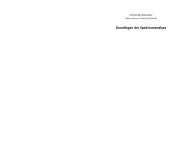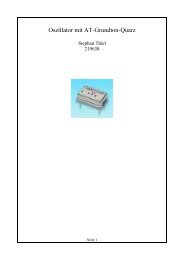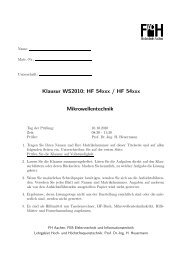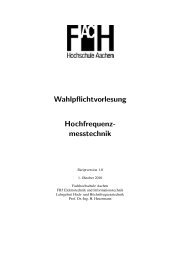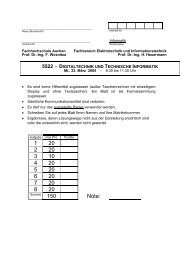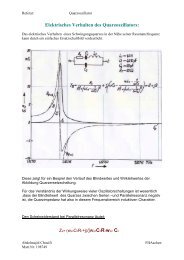Grundlagen der Digitaltechnik - Ing. H. Heuermann - FH Aachen
Grundlagen der Digitaltechnik - Ing. H. Heuermann - FH Aachen
Grundlagen der Digitaltechnik - Ing. H. Heuermann - FH Aachen
Erfolgreiche ePaper selbst erstellen
Machen Sie aus Ihren PDF Publikationen ein blätterbares Flipbook mit unserer einzigartigen Google optimierten e-Paper Software.
114 Highspeed-Datentransfer<br />
NB7L86M<br />
Table 9. AC CHARACTERISTICS (V CC = 2.375 V to 3.465 V, V EE = 0 V; Note 13)<br />
Symbol Characteristic 40 C 25 C 85 C Unit<br />
V OUTPP<br />
Output Voltage Amplitude (@V INPPmin ) f in ≤ 4 GHz<br />
(See Figure 7)<br />
f in ≤ 8 GHz<br />
Min Typ Max Min Typ Max Min Typ Max<br />
240<br />
125<br />
f data Maximum Operating Data Rate 10.7 12 10.7 12 10.7 12 Gb/s<br />
t PLH , Propagation Delay to Dx/Dx to Q/Q<br />
t PHL Output Differential @ 1 GHz SEL/SEL to Q/Q<br />
(See Figure 7)<br />
t SKEW Duty Cycle Skew (Note 14)<br />
Device to Device Skew (Note 15)<br />
70<br />
110<br />
t S Set Up Time (Dx to SEL) 100 100 100 ps<br />
t H Hold Up Time (Dx to SEL) 15 15 15 ps<br />
t JITTER RMS Random Clock Jitter (Note 16) f in = 4 GHz<br />
f in =8 GHz<br />
Peak/Peak Data Dependent Jitter f data = 5 Gb/s<br />
(Note 17)<br />
f data =10 Gb/s<br />
350<br />
230<br />
90<br />
135<br />
2.0<br />
5.0<br />
0.2<br />
0.2<br />
2.0<br />
4.0<br />
120<br />
180<br />
10<br />
20<br />
0.5<br />
0.5<br />
8.0<br />
10<br />
240<br />
125<br />
70<br />
110<br />
350<br />
230<br />
90<br />
135<br />
2.0<br />
5.0<br />
0.2<br />
0.2<br />
2.0<br />
4.0<br />
120<br />
180<br />
10<br />
20<br />
0.5<br />
0.5<br />
8.0<br />
10<br />
240<br />
125<br />
70<br />
110<br />
350<br />
230<br />
90<br />
135<br />
2.0<br />
5.0<br />
0.2<br />
0.2<br />
2.0<br />
4.0<br />
120<br />
180<br />
10<br />
20<br />
0.5<br />
0.5<br />
8.0<br />
10<br />
mV<br />
ps<br />
ps<br />
ps<br />
V INPP<br />
Input Voltage Swing/Sensitivity<br />
(Differential Configuration) (Note 18)<br />
75 400 2500 75 400 2500 75 400 2500 mV<br />
t r Output Rise/Fall Times @ 1 GHz Q, Q<br />
t f (20% 80%)<br />
35 60 35 60 35 60 ps<br />
NOTE: Device will meet the specifications after thermal equilibrium has been established when mounted in a test socket or printed circuit board<br />
with maintained airflow greater than 500 lfpm. Electrical parameters are guaranteed only over the declared operating temperature range.<br />
Functional operation of the device exceeding these conditions is not implied. Device specification limit values are applied individually<br />
un<strong>der</strong> normal operating conditions and not valid simultaneously.<br />
13.Measured by forcing V INPP (TYP) from a 50% duty cycle clock source. All loading with an external R L = 50 to V CC .<br />
Input edge rates 40 ps (20% 80%).<br />
14.Duty cycle skew is measured between differential outputs using the deviations of the sum of Tpw and Tpw+ @1 GHz.<br />
15.Device to device skew is measured between outputs un<strong>der</strong> identical transition @ 1 GHz.<br />
16.Additive RMS jitter with 50% duty cycle clock signal.<br />
17.Additive peak to peak data dependent jitter with input NRZ data (PRBS 2^23 1).<br />
18.V INPP (MAX) cannot exceed V CC V EE . Input voltage swing is a single ended measurement operating in differential mode.<br />
500<br />
OUTPUT VOLTAGE AMPLITUDE (mV)<br />
400<br />
300<br />
200<br />
100<br />
V CC V EE = 3.3 V<br />
V CC V EE = 2.5 V<br />
0<br />
0<br />
1<br />
2<br />
3<br />
4<br />
5<br />
6<br />
7<br />
8<br />
9<br />
10<br />
11<br />
12<br />
INPUT FREQUENCY (GHz)<br />
Figure 7. Output Voltage Amplitude (V OUTPP ) versus<br />
Input Clock Frequency (f in ) at Ambient Temperature (Typical)



